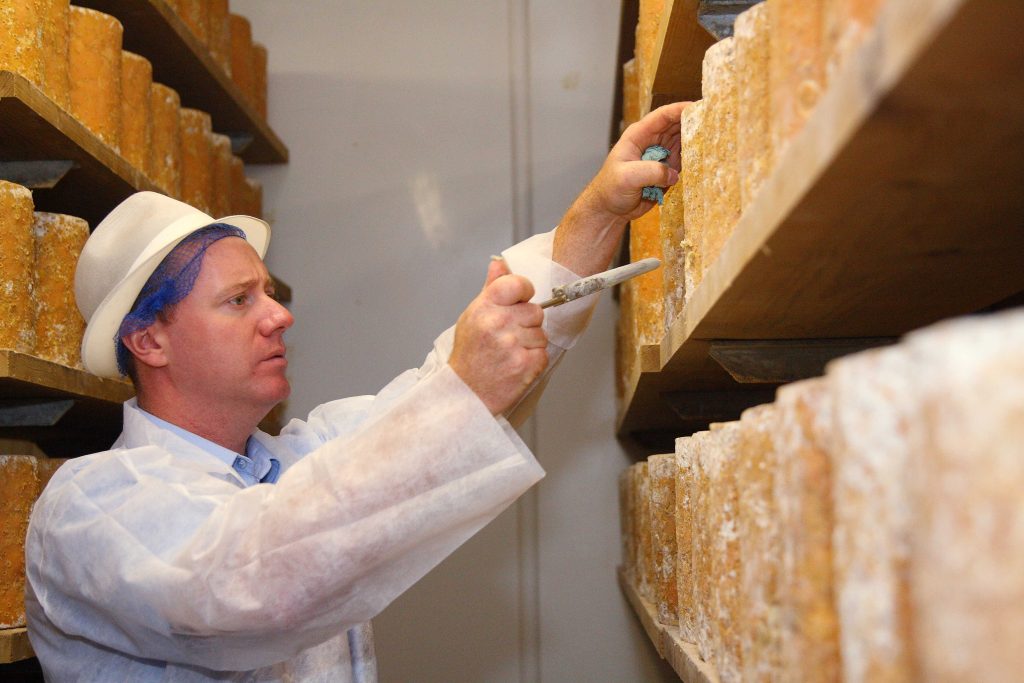Stilton: Not just for Christmas
21st November 2022
The beautiful cheese that adorns most Christmas tables across Britain is made right here on our doorstep. Billy Kevan, CEO at Colston Bassett Dairy, talks to Rebecca Jordan at the very busiest time of year

Words: Rebecca Jordan of Kitchen Confident
Christmas just isn’t the same without a Stilton, and the real thing has no rivals. What effort and time goes into making the legendary cheese?
Blue Stilton is a mould-ripened blue cheese, which has to conform to a strict code of best practice, trademark rules and Product Designation of Origin rules. The very nature of the manufacturing process makes it extremely difficult to produce well.
Is the process of making one cheese much like making another?
Each whole Stilton cheese requires around 72 litres of milk, which by law must be pasteurised; this volume gives around 8kg of cheese. Once formed, every individual cheese is matured for eight to 14 weeks and it has to be physically turned by hand at regular intervals throughout. This allows the cheese’s crust to form naturally in an air-dried environment. The distinctive blue veining associated with Blue Stilton cheese is created by adding blue mould spores to the cheese and introducing oxygen at a pre-determined point during the maturation process.
Most cheese is made using very few ingredients; usually this is milk, a live lactic-acid-forming bacteria called a starter culture, an enzyme called rennet, and salt. These raw materials are manipulated by the skill of the cheesemaker to produce hundreds of differing varieties of cheese.
Stilton can only officially come from the East Midlands. Tell us the story.
Blue Stilton has been made in the East Midlands for generations. Originally, the cheese was extremely variable with no set recipe and no real protection for the consumer or indeed the provenance of the cheese itself. In 1936 it was agreed amongst the existing makers of Blue Stilton that the cheese should achieve a minimum standard before it could be called Stilton, and the Stilton Cheesemakers’ Association (SCMA) was created. The newly formed group documented minimum standards that must be followed before the cheese could be called Stilton, such as size, shape, appearance, and taste, and it’s still followed today.
In 1966, to protect further the name Stilton from substandard imposters, Stilton became a trademark, and, in addition to this, the SCMA applied for and attained protected status for Stilton cheese. This protected status, called Product Designation of Origin (PDO), meant that legally Stilton must be made from milk produced within the three counties of Nottinghamshire, Leicestershire and Derbyshire and that the cheese must also be manufactured strictly in the same three counties with no exception. Currently, the members of the SCMA producing Stilton cheese must conform to all three standards, making this one of the most regulated cheeses produced in the UK.
What’s on your Christmas cheese board? And how should we all be serving it?
Stilton is traditionally associated with Christmas. Given the nature of the festive period it’s no surprise that families meeting for food and celebration would turn to a distinctive British cheese (why wouldn’t you)… Stilton is a hugely versatile cheese: you can eat it on its own; it pairs beautifully with sweet treats such as fruit cake; I like to put Blue Stilton on top of a warm mince pie. The salty cheese works with most things, sweet or savoury. Drinking alcohol? Any decent wine, dark beer or port works equally well. Just remember that Blue Stilton cheese is best eaten at room temperature – this allows all the complex flavours to be fully appreciated.
Can you describe the perfect Stilton in flavour – and tell us about the most memorable dish you’ve had with Stilton?
A good Blue Stilton should be fully balanced, a little acidic, slightly salty with an almost cheesy, ice cream-like, melt-in-the-mouth texture with a nice hint of blue coming through. My favourite way to enjoy Blue Stilton is on fresh, warm bread with a thin layer of real butter and a thick slice of cheese paired with a slightly sweet rosé wine. Utterly delicious.



